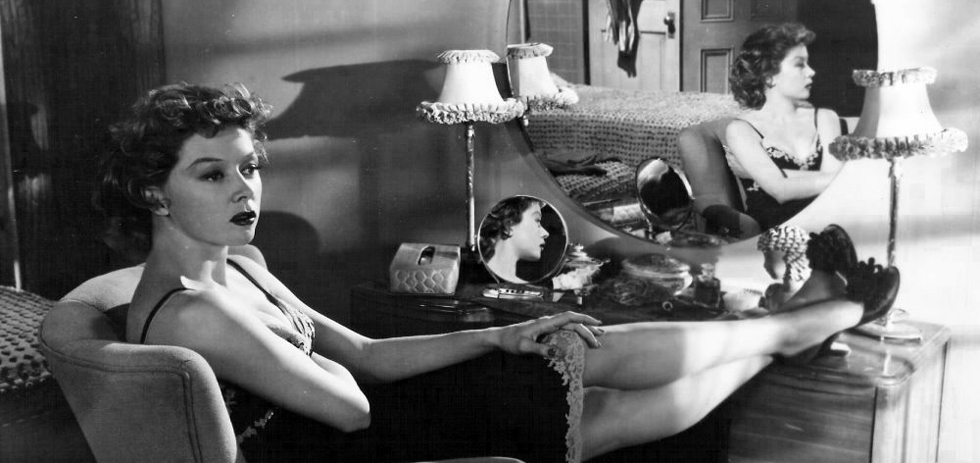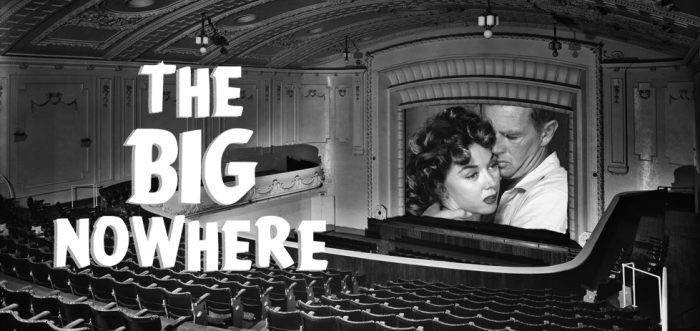The Big Nowhere (to be seen) is a new short-run feature that will run for eight separate installments, all penned by Melbourne-based writer Andrew Nette. The aim of this column is to focus on the best noirs that most people have never heard of and what they tell us about what film noir is, looking at plot, production and reception.
By the standards of classic film noir there’s nothing particularly special about the plot of Jerry Hopper’s 1954 B-noir, Naked Alibi. A Los Angeles policeman dismissed from the force for alleged brutality becomes obsessed with tracking down a man he believes is responsible for murdering three of his colleagues. He follows the suspect to a down-at-heel town on the Mexican side of the US border, where the two men become embroiled in a three-way relationship with a local nightclub singer. Desperate men, a femme fatale, jealously, obsession, set in a seedy small town, just your average film noir cocktail.
What makes this otherwise average film worth seeing is the presence of Sterling Hayden as the disgraced cop and Gloria Grahame as the singer, two of the most interesting actors who worked in film noir in the late ’40s and ’50s.
The Film
Naked Alibi opens with three cops sweating a suspect in an interrogation room. Willis (Gene Barry) has been brought in for being drunk and disorderly, but the cops suspect he might be involved in a string of unsolved robberies. Willis has an obvious mean streak to his personality, but that’s no crime. He professes his innocence and tells the cops he is a happily married family man who owns a bakery.
When Chief Joe Conroy (Hayden) enters the room, things get rough. Willis jumps his captors and threatens that he’ll get even with them for daring to arrest him. Conroy helps subdue Willis but the suspect’s alibi checks out and the police have no choice but to release him. That same night one of the cops involved in the interrogation is gunned down. The other two are killed in a car bomb soon after. Conroy is convinced that Willis is behind the deaths. Convoy arrests Willis at a wedding but, again, can’t prove he is involved in anything illegal and has to cut him loose.

Conroy takes heat from his superiors and a politically ambitious local councilman for police brutality and harassing “a respectable citizen”, and he is dismissed from his job. Willis, meanwhile, has fled Los Angeles for a sleazy, crime-ridden town on the Mexican side of the US frontier known as Border Town (a thinly veiled version of Tijuana); Conroy follows.
South of the border, Willis sheds any pretence he had of being a mild mannered baker and turns into a snarling hoodlum. He has a local girlfriend, Marianne (Grahame), who makes a living serenading bar flies in a local dump called El Perico. Marianne is in love with Willis but tiring of being kept on a string while he spends time with his wife and kids in Los Angeles. For his part, Willis is hugely possessive of Marianne, so when she takes a shining to ex-cop Conroy, who is recovering after being mugged on his first night in Border Town, the two men move towards an inevitable showdown.
The Trope
Mexico was the destination of choice for characters in many film noirs. In Kansas City Confidential (1952), an ex-con trying to go straight ventures to Mexico to find the men responsible for an armoured car robbery he has been framed for. Don Siegel’s The Big Steal (1949) sees Robert Ryan, an army lieutenant accused of robbery, and Jane Greer, head south to try and find the real thief. And in Robert Montgomery’s classic, Ride the Pink Horse (1947), a tough loner arrives in a Mexican border town at fiesta time in pursuit of an equally mysterious man.
The Naked Alibi’s director, Hopper, had a long and undistinguished career in B-movies and television. Lawrence Roman, who is responsible for the script, did a number of better-known films, including A Kiss Before Dying (1956) and the revisionist Western, Red Sun (1971), before also settling into a career in television. Barry, who got his start in musical theatre and is best know for his turn as Dr Clayton Forrestor in the 1953 movie, The War of the Worlds, is good as the vicious hoodlum, Willis, but this film belongs to Hayden and Grahame.
Hayden played a lot of characters like the one in Naked Alibi during his career, criminals and tough cops, cynical, world-weary men. He could project hard-nosed masculinity but many of his performances also have a laid back, don’t give a damn quality. This was very much a case of art imitating life. Hayden, who got his start in movies in 1941, was openly contemptuous of Hollywood. When the Japanese bombed Pearl Harbour he changed his name and enlisted in the Office of Strategic Services, the forerunner of the Central Intelligence Agency, where he ran German naval blockades to smuggle guns to Yugoslavian partisans. After the war, he briefly joined the Communist Party and campaigned in support of the ‘Hollywood 19’ against the House of Un-American Activities Committee. He only returned to film work in order to pay for his great passion, sailing boats. He even got jaded on politics, saying he regretted joining the Party and only did it so he could hang around drinking at parties and chase women.
Grahame had a lengthy career, which peaked in the late forties and fifties when she appeared in a swag of excellent film noirs, including Crossfire (1947, for which she won an Academy Award for Best Supporting Actress), In a Lonely Place (1950, opposite Humphrey Bogart), The Good Die Young (1954), The Big Heat (1953, famous for the scene in which Lee Marvin disfigures her with scalding coffee) and Odds Against Tomorrow (1959).
Her performances are notable for the way she manages to move beyond the often one-dimensional characters she was given and inject a sense of complexity and reality into them. Her performance in Naked Alibi is a case in point. Marianne is a low life dancer looking to get out of her relationship with a vicious hood. In the hands of a lesser talent, it would have stayed pretty much at that. But Grahame imbues the character with much greater depth. Marianne is smarter than most of the men in the movie and exudes a sense of restless sexual energy which doesn’t come off as being desperate or promiscuous. This latter quality, along with her acting talent, made more than a few of her leading men look uncomfortable alongside her. In his biography of the actress, Suicide Blonde, author Vincent Curcio states that Grahame came onto Hayden so strongly she frightened him off and it definitely shows in this film.
During the making of Naked Alibi, Grahame already had acted on her obsession with plastic surgery, something that would continue well into her all too short life. She died of complications of cancer at just 51 years of age.
Naked Alibi is unavailable on DVD release but a decent version of it can be viewed in full on YouTube.
Andrew Nette is a Melbourne-based writer and reviewer, whose work on film has been published widely. He is co-editor of Beat Girls, Love Tribes and Real Cool Cats: Pulp Fiction and Youth Culture, 1950 – 1980, forthcoming in early 2016. His online home is www.pulpcurry.com. You can find him on Twitter at @pulpcurry
The header image for this series modifies a photo from the Harold Paynting Collection at State Library of Victoria and is used by 4:3 under a CC BY 2.0 license.
